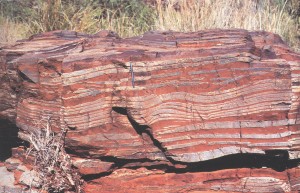Most of us are familiar with the Earth’s magnetic field as the invisible force directing our compasses to the north. But if you took a time machine back 800,000 years and followed the red needle, your compass would send you south instead of north; zip back another 200,000 years and you would be headed north again.
Why the changes in direction? The Earth’s magnetic field, produced by turbulent motions deep in Earth’s interior, is susceptible to reversals in polarity, which occur sporadically due to instabilities in the liquid outer core. New research by Yale Geology & Geophysics professor David Evans and former Yale postdoctoral researcher Peter Driscoll of the Carnegie Institution reveals the occurrence of these reversals through much of Earth’s history, and hints at a biography for the Earth’s magnetic field: an unstable and murky “adolescence” roughly two billion years ago, followed by a stable maturity only briefly interrupted by a “mid-life crisis” 800 to 500 million years ago. This new, surprising timeline of the geomagnetic field raises important questions about the relationship between Earth’s interior and the magnetic field that it produces.

To reconstruct the history of Earth’s magnetic field, Evans analyzed rocks that record the magnetic field’s direction. Like tiny compasses, minerals in iron-rich rocks orient their magnetic directions to align with the Earth’s magnetic field during rock formation; these patterns can then be “read” to indicate magnetic north at the time of formation. Evans and Driscoll focused on the period from 2.0 to 0.9 billion years ago, from which data has been historically scarce and difficult to interpret due to the scarcity of old, unaltered magnetic rocks. But years of research by Evans and other “paleomagnetic” experts has produced a global database of paleomagnetic data from this period extensive enough to produce robust conclusions.
After analyzing this new historical record, Evans and Driscoll were particularly surprised by the similarity in the behavior of the magnetic field from two billion to 900 million years ago compared to the last 500 million years. Aside from two brief periods of disrupted behavior—the “adolescent” period and “mid-life crisis”—the behavior of the magnetic field, and specifically the frequency of superchrons, or periods of at least 10 million years with one dominant polarity, appear to have been similar for most of the past 2 billion years.
This stability is surprising because Evans and Driscoll believe that the Earth’s core underwent a dramatic change during this time period, which they expect would have had a lasting impact on the behavior of the magnetic field. Previous research suggests that the core was entirely liquid until about 700 million years ago, when the nucleus of a solid iron core formed and began to grow. The slow solidification of the solid inner core is expected to influence fluid motion and magnetic field generation in the outer core due to the additional heat release and changing geometry. Evans and Driscoll believe these changes may have facilitated the recovery from the “mid-life crisis,” but they expected that the crisis would have had lingering effects. “What surprised us was that the field before and after the mid-life crisis was so similar, because we think that the physical generation mechanism of the Earth’s magnetic field would be very different with and without a solid inner core,” Evans said.
Researchers like Driscoll will need to consider how this newly confirmed stability informs their models of the evolution of the core and magnetic field. “The elephant in the room is, when did the inner core first start solidifying?” said Driscoll. “Is there an observational signature of the event?”
Meanwhile, Evans hopes to better understand what was going on during the two “crises,” when the magnetic field differed greatly from its current state. “How was the magnetic field different in those times of crisis? That’s the more exciting frontier for me,” said Evans.
